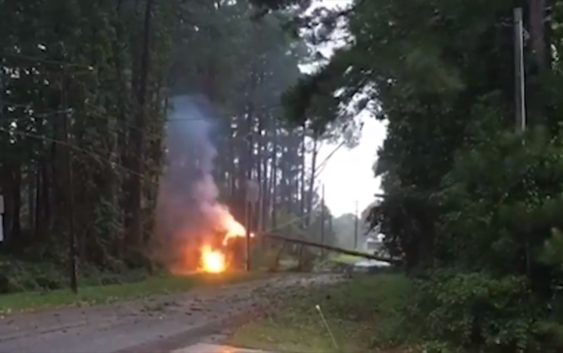- Mexico sends firefighters to aid in fight against Los Angeles wildfires
- Bexar County crews send resources to assist efforts to combat wildfire scorching South California
- Mexico sends firefighters to aid in fight against Los Angeles wildfires
- San Antonio bakery to donate proceeds from new item to California wildfire victims
- Firefighters from San Antonio area deploy to fight California wildfires
As if Florence’s flooding wasn’t enough, now we have to worry about these 5 creatures

Here are 5 risks that come with floodwater
Biggest hazards sometimes come after the storm.
By
By
It’s been weeks since Hurricane Florence slammed into parts of North and South Carolina and many are still living with the damage the storm caused.
Florence not only brought high, damaging winds, but several feet of water that has ruined homes and displaced wildlife.
Floodwater carries with it a long list of diseases and bacteria, according to the Centers for Disease and Control. Even after the waters have receded, mold can become a problem for those with allergies or asthma.
Those aren’t the only problems to arise in the wake of the storm. Insects, rodents and other animals can also poise a problem for storm-weary residents.
From mega-mosquitoes to alligators swimming in a flooded dog parks, here are some after-storm visitors you need to watch for:
1. Mega-mosquitoes
Mosquitoes love large bodies of water, so it’s not shocking that when hurricanes cause floods, that these pests appear.
However, Florence has brought a unique type of mosquito, to North Carolina especially.
Reports say that NC residents are seeing some of the largest mosquitoes the region has ever hast.
Swarms of these “mega-mosquitoes” are unique due to their large size and signature white strips on their legs and body.
People are jokingly comparing the size of these pests from as small as wasps to as big as blackbirds.
2. Alligators
Alligators come up from their usual home in lagoons and swamps as water levels rise due to flooding.
One flooded dog park in Conway had an unexpected visitor when a gator swam around for a bit, reported WMBF.
Be extra careful standing near or in any body of water just in case alligators or snakes are swimming below the surface.
3. Snakes
Like alligators, snakes already live in or near lagoons or rivers, so when water levels rise, the reptiles will swim wherever they can to get to higher ground.
If you have to walk in floodwater and think you’ve been bitten these are the signs you should look for according to CDC:
- A pair of puncture marks at the wound
- Redness and swelling around the bite
- Severe pain at the site of the bite
- Nausea and vomiting and labored breathing (in extreme cases, breathing may stop altogether)
- Disturbed vision
- Increased salivation and sweating
- Numbness or tingling around your face and/or limbs
The most important thing to do if you’re bitten, other than to summon help, is to try to identify what type of snake bit you.
The South Carolina Department of Natural Resources offers a list of venomous snakes in South Carolina. Thankfully, out of the 38 species that live here only six are venomous.
4. Rodents
Mice and rats are another danger and annoyance after hurricanes, but you might not notice until six to ten months after they’ve invaded, according to CDC.
The rodents who survive the floodwaters will find higher ground in nooks and crannies, and the vermin will try to find food, shelter and water to continue surviving.
Rodents can be dangerous since they often carry diseases and contaminate food.
Make sure to keep all food properly sealed and contained and to always double-check for rat droppings, marks, or burrows after the water recedes.
5. Displaced Wildlife (Fish, dogs, cats, and more)
Hurricanes wreak havoc not only on land, but in the sea and the saltwater fish that live in it.
All types of saltwater fish and ocean life can be washed onto shore after a hurricane.
Sometimes, something bigger can, such as the whale that washed up onto Caswell Beach, NC, after Florence, according to The Herald Sun.
In North Carolina, I-40 was littered with dead fish once the waters receded and firefighters from the Penderlea Fire Department had to clean up and wash away the rotting fish, reported The Charlotte Observer.
Once the hurricane dies down into a tropical storm, then depression, it leaves behind floodwaters that not only displace people, but animals.
Sadly people sometimes do leave pets behind. Even if they don’t, there are a number of stray dogs and cats that have to fend for themselves during a hurricane.
CDC warns that stray animals — particularly dogs — can be frightened, lost or hurt and may be more likely to attack if provoked.
I